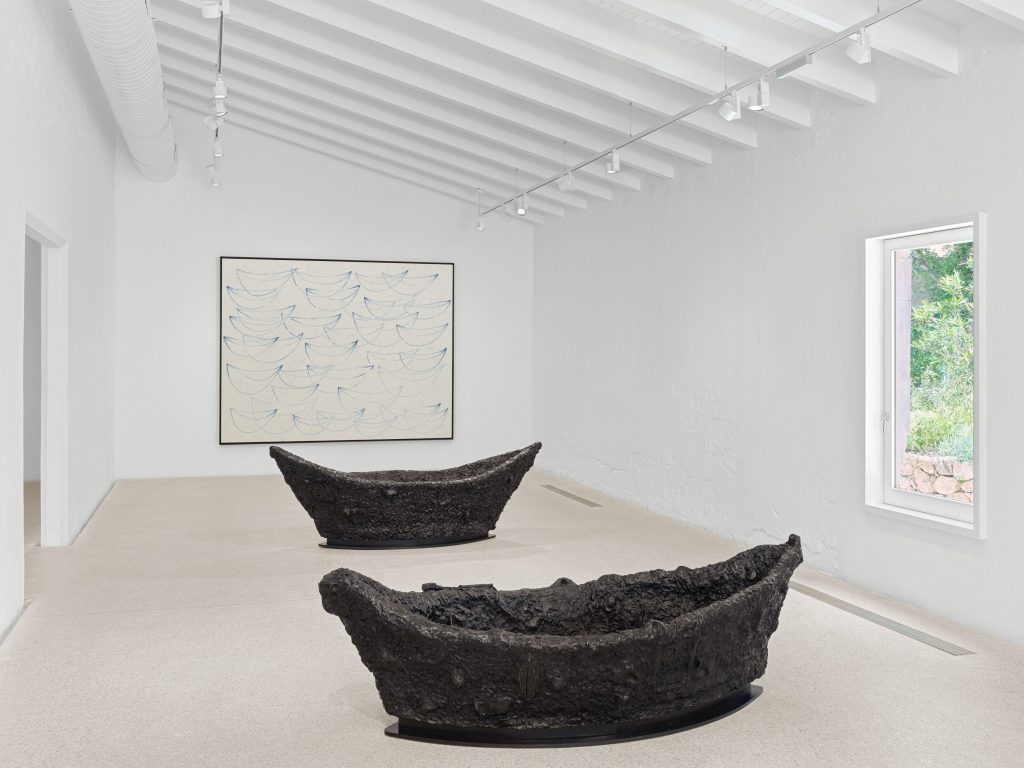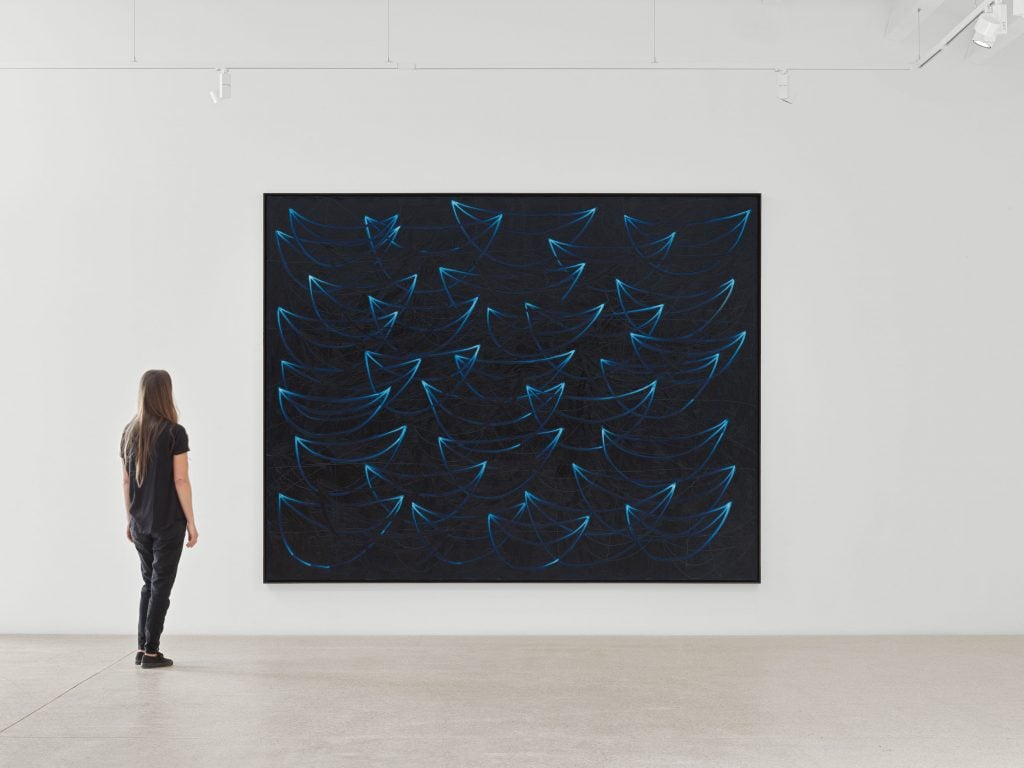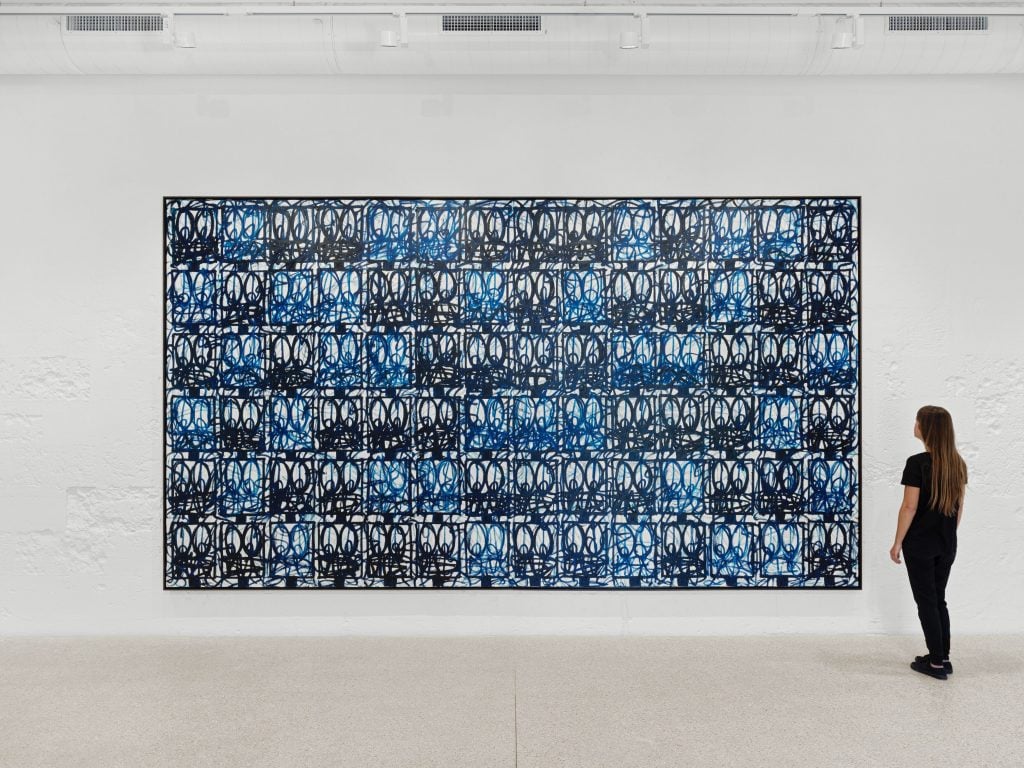Reviews
Rashid Johnson Has Unveiled an Ambitious New Series of Ocean-Inspired Artworks on the Spanish Island of Menorca
Bronze boat sculptures and new paintings are on view in the gallery's space in the Mediterranean.

Bronze boat sculptures and new paintings are on view in the gallery's space in the Mediterranean.

Naomi Rea

On a balmy Saturday evening on the tiny island of Menorca, off the coast of Spain, visiting art-world denizens mixed with residents to raise a pomada—a gin and lemon-based elixir favored by the locals—to Rashid Johnson. The 45-year-old Chicago-born, New York-based artist was there inaugurating his latest solo exhibition, “Rashid Johnson: Sodade,” with mega-gallery Hauser and Wirth.
The gathering, organized immediately off of the back of Art Basel, was the first full-size event the gallery has been able to throw at its location on the Mediterranean island, which opened last year during the pandemic. Some 600 invitees poured onto Isla del Rei, the site of a decommissioned 18th-century naval hospital, which Hauser and Wirth have converted into a 16,000-square-foot gallery space, gift shop, and restaurant.
The artist taking center stage has become something of a market star thanks to the popularity of his “anxious men” series, frenetic and repetitive gesture paintings of abstracted faces in various hues. The works have struck a chord with buyers for their ability to simultaneously speak to the anxieties of our current moment as well as connect to art-historical movements such as Abstract Expressionism.

Installation view, “Rashid Johnson: Sodade” at Hauser & Wirth Menorca, 19 June–13 November 2022. © Rashid Johnson. Courtesy the artist and Hauser & Wirth. Photo: Stefan Altenburger.
The exhibition, Johnson’s first solo show in Spain, takes its title from a Creole word derived from the Portuguese “saudade,” popularized in the 1950s by a song by the Cape Verdean musician Cesária Évora. It is a ballad of homesickness, which also contains a note of resilience—of hopefulness in building something new in the face of loss, much like Creole languages themselves evolved in defiance of the language of their oppressors.
In borrowing it, Johnson engages with a critical history and with narratives around migration and journeys, particularly surrounding the ocean, evoking everything from the transatlantic slave trade to the contemporary migrant crisis.

Installation view, “Rashid Johnson. Sodade” at Hauser & Wirth Menorca, from 19 June–13 November 2022. © Rashid Johnson. Courtesy the artist and Hauser & Wirth. Photo: Stefan Altenburger.
The exhibition includes 14 new paintings, and four sculptures, all made in the past two years. The bronze sculptures are the most revelatory. Cast from clay, their hollowed-out forms recall row-boats but are actually—and perhaps conveniently, for collectors looking to revamp their summer gardens—functional fire pits, referencing the vessels use as pyres in funerary rituals from around the world.
They have been embedded with found objects that are significant to the artist, from VHS tapes to books to a radio, which Johnson said was a reference to the citizens band radio. His father used to use the short-distance bidirectional communication device, but in the time of Black Lives Matter, the object also evokes the look of police radios, often used to harm and harass Black communities.
The same ambiguity infuses the presence of oyster shells in the works, which Johnson explained is a reference to Zora Neale Hurston’s essay How it Feels to be Colored Me, in which she wrote: “No, I do not weep at the world, I’m too busy sharpening my oyster knife.” The artist said, somewhat enigmatically, that he was drawn to the duality of the aggressive notion of sharpening a knife and the opulence of using it for eating oysters.

Installation view, “Rashid Johnson. Sodade” at Hauser & Wirth Menorca, from 19 June–13 November 2022. © Rashid Johnson. Courtesy the artist and Hauser & Wirth. Photo: Stefan Altenburger.
The symbolism of the boat forms are echoed in crescent-shaped “seascape” paintings, inspired by Johnson’s time living in the Hamptons on Long Island during the pandemic. For these, Johnson has traded his familiar materials such as shea butter and black soap for oil paint, which he wiped away and scratched into thick layers of blue and white.
These are joined by new iterations of Johnson’s well-known “anxious men” motifs, two-tone paintings made with white oil paint on raw canvas. The artist refers to these washed out ghostly images as “surrender” paintings, and they are quickly becoming as coveted as earlier variations on the theme (the gallery sold one of these at Art Basel this year for $975,000).

Installation view, “Rashid Johnson. Sodade” at Hauser & Wirth Menorca, from 19 June–13 November 2022. © Rashid Johnson. Courtesy the artist and Hauser & Wirth. Photo: Stefan Altenburger.
These works, which he said evoke acceptance and reconciliation, are a natural follow on to the earlier iteration of black and blue works begun in 2021, which Johnson calls his “bruise” paintings, suggesting damage as well as healing. A series of those are also on view in the show, although the more violent red paintings created at the beginning of the pandemic are not present.
In all, the show is full of attractive, if largely expected works from a commercial gallery. Along the way, we are constantly reminded that the space is keen on being perceived as more like a museum than a gallery, and one is left to wonder why it did not organize a mini-retrospective that would convey a greater sense of what Johnson’s challenging work is all about, rather than simply marketing new pieces. One wonders what Johnson, who made a jovial appearance at his party, thinks of all this. But then again, perhaps he’s too busy sharpening his oyster knife.
“Rashid Johnson. Sodade” is on view through November 13 at Hauser and Wirth, Menorca.